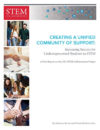Achieving Scale for STEM Reform | Report | Research Team | Background & Goals | Further Resources | Funding
Reports

Creating a Unified Community of Support: Increasing Success for Underrepresented Students in STEM
Adrianna Kezar, Elizabeth Holcombe (2017)
For decades, researchers have tried to boost the very low success rates of first-generation, low-income and underserved minority students in STEM education in college. Yet while more students from these groups have been entering colleges and pursuing STEM majors, the vast majority still are not earning STEM degrees. This report presents timely ideas for changing that trend.
Based on a study of the California State University STEM Collaboratives, a three-year project that provided immersive educational experiences to incoming STEM students on eight CSU campuses, this final report reviews findings on the value of the project for the broader campus community, the process of collaborating across departments and divisions and implementation challenges unique to creating integrated programs. The authors’ main takeaway is that specific interventions matter less than the integration of multiple support programs and collaboration across the academic affairs and student affairs divide.
Categories: STEM Reform
Download 967.09 KB 16938 Downloads
Journal Articles
Holcombe, E. M., & Kezar, A. (2020). Exploring the Organizational Value of Integrated Transition Programs for Underrepresented College Students. Journal of Student Affairs Research and Practice, 1-14. https://doi.org/10.1080/19496591.2020.1726358
Kezar, A., & Holcombe, E. (2019). The Role of Collaboration in Integrated Programs Aimed at Supporting Underrepresented Student Success in STEM. American Behavioral Scientist. https://doi.org/10.1177/0002764219869421
Holcombe, E., & Kezar, A. (2019). Ensuring Success Among First-Generation, Low-Income, and Underserved Minority Students: Developing a Unified Community of Support. American Behavioral Scientist. https://doi.org/10.1177/0002764219869413
Kezar, A. J., & Holcombe, E. (2018). Challenges of implementing integrated programs for underrepresented students in STEM: A study of the CSU STEM collaboratives. Educational Policy. https://doi.org/10.1177/0895904818802091
Kezar, A., & Holcombe, E. (2018). Integrated and comprehensive student support programs aimed at historically underserved students: Creating a unified community of support. International Journal of Chinese Education, 7(1), 65-84. https://doi.org/10.1163/22125868-12340090
Kezar, A., & Holcombe, E. (2018). How organizational silos and bridges shape student success: The CSU STEM collaboratives project. Change: The Magazine of Higher Learning. 50(2). https://doi.org/10.1080/00091383.2018.1483180
Research Team
Adrianna Kezar
Project Lead and Co-Principal Investigator
Elizabeth Holcombe
Research Assistant
Background
The California State University STEM Collaboratives project is designed to apply grass-roots expertise and strong, continuous evaluation to solve two persistent problems in STEM education: student attrition and institutional inertia. Attrition is steepest at entry, particularly for the students historically underserved by present educational practice: ethnic minorities, those who are eligible for financial aid, and those whose parents didn’t attend college. As reported in 2012 by the President’s Council of Advisors for Science and Technology (PCAST), most of the students who leave STEM majors do so in the first two years, and while in good academic standing:
“In the United States, fewer than 40% of the students who enter college with the intention of majoring in a STEM field complete a STEM degree. Most of the students who leave STEM fields switch to non-STEM majors after taking introductory science, math, and engineering courses. Many of the students who leave STEM majors are capable of the work, making the retention of students who express initial interest in STEM subjects an excellent group from which to draw some of the additional one million STEM graduates. Many students who transfer out of STEM majors perform well, but they describe the teaching methods and atmosphere in introductory STEM classes as ineffective and uninspiring.”
The same national patterns identified by PCAST appear in the CSU. Fewer than a third of the students who entered the CSU in Fall 2005 declaring majors in STEM had earned STEM degrees six years later. For students from under-represented minority groups (Native American, African American, and Latino) the six-year STEM graduation rate is half that, or 17%. That is, of every six of these students who want STEM degrees, only one will make it. Degree completion rates for other at-risk and differentially-abled groups – even by gender in some STEM disciplines – are similarly disappointing.
Related to the chronic attrition problem is one of institutional inertia. CSU faculty members have worked for decades to improve delivery of STEM education, with repeated concentration on gateway courses in particular. At the same time, CSU universities are national leaders in proven interventions like summer bridge and first-year experiences.
Yet these innovations have defied integration and systemization at scale. Instead they survive on grant money and the goodwill of individual faculty and administrators, making them vulnerable to economic downturns, staffing turnover, or sheer fatigue.
The premise of this project is that the CSU already has all the incoming students and pedagogical evidence that it needs to provide California with an ample and diverse supply of STEM graduates. What’s missing is a new conception of the status quo, with sustained faculty and professional development and other administrative structures that build engaging, evidence-based practices into curriculum, policy, the business model, and day-to-day practice, so that our best work is offered consistently, systematically, and reliably.
Project Design and Research Goals
The California State University STEM Collaboratives project awarded funding from the Leona M. and Harry B. Helmsley Charitable Trust to eight CSU campuses to test and implement projects incorporating three high-impact educational practices (HIPs): pre-college summer bridge programs, first-year experience courses or programs, and redesigned introductory gateway STEM courses.
By integrating several intervention strategies into one comprehensive program and by integrating projects into existing campus programs and resources, the CSU STEM Collaboratives also aimed to investigate how to make long-term and sustainable changes to the ways universities support STEM student success.
The Pullias Center for Higher Education worked with the CSU and the Helmsley Trust to examine the impact of the project using a mixed-methods study design. The project investigated the following project goals:
- Increased persistence in STEM majors. Do the projects lead to increased persistence for STEM students?
- Understand the value of the three interrelated interventions. Are there benefits or advantages of connecting the three interventions? Are different types of integration or connection more beneficial for student success or for project sustainability? Are certain forms or designs of each intervention more successful than others?
- Understand whether the projects shape or alter campus climates related to student learning and support in STEM fields. How do the projects change values and behaviors within STEM departments? How does this look different across campus sites? What characteristics of project design are associated with different degrees of change?
Publications

Creating a Unified Community of Support: Increasing Success for Underrepresented Students in STEM
Adrianna Kezar, Elizabeth Holcombe (2017)
For decades, researchers have tried to boost the very low success rates of first-generation, low-income and underserved minority students in STEM education in college. Yet while more students from these groups have been entering colleges and pursuing STEM majors, the vast majority still are not earning STEM degrees. This report presents timely ideas for changing that trend.
Based on a study of the California State University STEM Collaboratives, a three-year project that provided immersive educational experiences to incoming STEM students on eight CSU campuses, this final report reviews findings on the value of the project for the broader campus community, the process of collaborating across departments and divisions and implementation challenges unique to creating integrated programs. The authors’ main takeaway is that specific interventions matter less than the integration of multiple support programs and collaboration across the academic affairs and student affairs divide.
Categories: STEM Reform
Download 967.09 KB 16938 Downloads

High-Impact Practices (HIPs) Tool for Admins
Adrianna Kezar, Elizabeth Holcombe
This tool is a reflective guide for administrators who are interested in supporting high-impact practices on their campuses. Administrators can help champion and create supportive infrastructure, policies and rewards that are necessary for implementation, sustainability and scaling of high-impact practices on college and university campuses. For more about this tool, read "Support for High-Impact Practices: A New Tool for Administrators," a 2017 article by Kezar and Holcombe published in AAC&U's journal Liberal Education.
Categories: Guides
administrator stem
Download 122.67 KB 16235 Downloads
Papers
Kezar, A., & Holcombe, E. (2019) The role of collaboration in integrated programs aimed at supporting underrepresented student success in STEM. American Behavioral Scientist, 64(8). https://doi.org/10.1177/0002764219869421
Kezar, A. J., & Holcombe, E. M. (2018). Challenges of implementing integrated programs for underrepresented students in STEM: A study of the CSU STEM collaboratives. Educational Policy. https://doi.org/10.1177/0895904818802091
Kezar, A., & Holcombe, E. (2018). Integrated and comprehensive student support programs aimed at historically underserved students: Creating a unified community of support. International Journal of Chinese Education, 7(1), 65-84. https://doi.org/10.1163/22125868-12340090
Kezar, A., & Holcombe, E. (2018). How organizational silos and bridges shape student success: The CSU STEM collaboratives project. Change: The Magazine of Higher Learning, 50(2), 48-56. https://doi.org/10.3102/0002831217746107
Kezar, A., & Holcombe, E. (2018). The promise of comprehensive and integrated college transition programs. Institute of Education Tsinghua University Press.
Kezar, A., & Holcombe, E. (2017). Support for high-impact practices: A new tool for administrators. Liberal Education, 103(1). https://www.aacu.org/liberaleducation/2017/winter/kezar_holcombe
Op-Ed
Kezar, A., & Holcombe, E. (2019, January 14). An overlooked solution for diversifying STEM. Inside Higher Ed. https://www.insidehighered.com/views/2019/01/14/recommendations-making-stem-education-more-diverse-opinion
Blog Posts
Holcombe, E. (2018, February 21). Integrating across academic and student affairs to support underrepresented students in STEM: Lessons from the CSU STEM collaboratives. Accelerating Systemic Change Network (ASCN). https://ascnhighered.org/ASCN/posts/200235.html
Holcombe, E. (2018, March 21). Implementing integrated comprehensive student programs in STEM: Challenges and facilitators from the CSU STEM collaboratives. Accelerating Systemic Change Network (ASCN). https://ascnhighered.org/ASCN/posts/201810.html
Webinar
Holcombe, E. (2018, March 28). Creating a unified community of support: Increasing success for underrepresented students in STEM [Video]. https://ascnhighered.org/ASCN/webinars/community_support/index.html#res
Funding
The CSU STEM Collaboratives project is funded through a $4.6 million grant from the Leona M. and Harry B. Helmsley Charitable Trust. Sub-grants directly to each of the 8 CSU campus project sites fund projects for 30 months to provide a comprehensive and integrated first-year experience to students in STEM fields.
